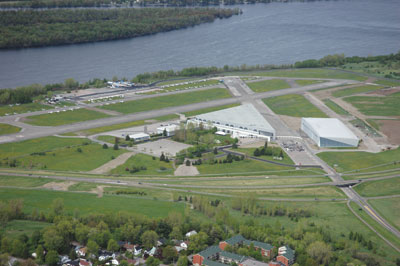
Features
Operations
45 ° 42′ North: Celebrating the ‘village green’
On the south shore of the Ottawa River, four nautical miles from the Parliament buildings, is a field that deserves its own historic marker.
February 24, 2011 By Peter Pigott
On the south shore of the Ottawa River, four nautical miles from the Parliament buildings, is a field that deserves its own historic marker. During the First World War, soldiers did target practice here before going off to the Western Front. A young William Lyon Mackenzie King, the future prime minister, drove here one hot August afternoon in 1918 to watch a Curtiss Jenny land with mail from Toronto. The site became an official airfield in 1920 as one of six that was opened across Canada by the Air Board. As RCAF Rockliffe, it was Canada’s first seaplane base and the old slipway where the first cross-Canada flight left in 1920 still exists; it has been used by the Canada Aviation and Space Museum to bring ashore several seaplanes for its collection.

|
|
| “Aviation and the arts has been a natural fit since the first humans took tentatively to the air.”
|
In 1931, the aviation celebrities Charles and Anne Morrow Lindbergh disembarked here from their Lockheed Sirius floatplane on their round-the-world flight. During the Second World War, Flying Fortresses packed with mail for Canadian soldiers in Europe lumbered down its runways. When the Air Force ceased active military flying from Rockcliffe in 1964, the historic site appropriately became home to the Rockcliffe Flying Club and the National Aviation Museum, some of which was then at Uplands Airport.
The priceless collection was initially housed in three Second World War hangars on the south side of the field before being moved to the present magnificent building in June 1988. A storage wing was added to bring the aircraft deteriorating in the open air under shelter. In early 2010, work began on the main entrance that is scheduled to be opened on Feb. 23, 2011, the anniversary of the flight of the Silver Dart.
Designed by Ottawa’s Cole+Associates Architects Inc., the 28-million square-foot main entrance to the museum is triangular in shape with floor to ceiling glass, and conveys a sensation of bright airiness. But when they enter, what visitors will notice first is a Snowbird aircraft suspended from the ceiling – upside down!
“The museum never had an entrance that served as a proper introduction to the collection,” said Stephen Quick, the new director general. “We wanted a structure open as much as possible to the sky. The glassed-in entrance is designed to give visitors a sense of taking off in flight.” And the upside-down Snowbird? “We chose the Snowbird aircraft because it is iconic. Millions of people see the Snowbirds across the country and around the world.”
Near the entrance and the enlarged boutique are classrooms equipped with video-conferencing and distance learning. Ottawa’s Algonquin College already has joint programs with the museum and they will be joined by Ryerson University and other community colleges. Any of the colleges would be pleased to have the 250-seat multi-purpose auditorium, complete with folding tables, on its campus.
“Museums need to be greater than the sum of their collections,” said Quick. They are honour bound to play a role as a meeting place for future ideas, dreams and a place to muse on the future predicated upon the mass and wealth of a nation’s collective past.”
Quick added that museums today “need to act as stewards of the collections entrusted to them but they need to engage their communities’ regional, national and – with the new reality – international interests. The ‘village green’ is a place to meet, exchange ideas and celebrate. Museums should be a place where knowledge is not only discovered but shared . . . and it is with these concepts and ideals in mind that the Canada Aviation and Space Museum seeks to enlarge its mandate and push the envelope by engaging the arts with its new facilities – and welcoming new communities to its ‘village green.’ Aviation and the arts has been a natural fit since the first humans took tentatively to the air and it is time to put them together in a national setting for Canadians to enjoy and celebrate.”
With this extension, the museum plans to offer film and theatre classes and is lobbying for the National Arts Centre to use its facilities as a venue for its regionally themed theatre festival. Soon to come is a botanical garden, an astronaut’s walk and art shows. Now that it has been named the Canada Aviation and Space Museum, its mandate will feature space exploration and in May 2011, in co-operation with the Canada Space Agency, it will feature a 2,000-square-foot exhibit entitled “Living in Space.”
It might be clichéd to say but, under its new director general, for the Canada Aviation and Space Museum, the sky is truly the limit.
Peter Pigott is a Wings writer and columnist.